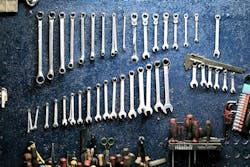Inventory Overload
According to Dave Piecuch, vice president of Automotive Consultants Group Inc., one of the biggest problems in the parts department is parts obsolescence and overstocked inventories.
Piecuch is NADA’s “fix-it guy” when it comes to parts. Armed with experience as a parts and a service manager, Piecuch knows first-hand the impact that an overstocked parts department can have on the success of the department. Piecuch even has his own email newsletter that he sends out through Automotive Consultants Group called “Smart Parts.”
From what he’s seen since starting in the industry in 1977, he estimates 25 percent of dealership’s have a parts inventory with 25–30 percent worth of obsolete parts. The longer a part sits on a shelf, the less of a chance that part has of ever being sold. Industry parts analyst Mike Nicoles says that after six months, parts with no sales have a 49 percent chance of no future sales. After 12 months, that figure jumps to 98 percent. That’s exactly why parts managers need to constantly check their inventory.
How exactly can this be done? Piecuch says the first step is to take stock of what’s going on in your parts inventory.
Assess The Situation.
So, how exactly does a parts department determine whether their inventory is correct? Piecuch shares a solution for recommended inventory amount:
Total annual parts sales at cost/8 inventory gross turns = recommended inventory amount
*8 inventory gross turns comes from NADA’s recommended annual parts inventory gross turns to represent a total days supply of parts inventory, which is 1.5 months supply. 12 divided by 8 is 1.5
If you have a total annual parts sales of $1,313,445, that means your recommended inventory amount should be $164,180.62. If your inventory amount exceeds this, then it’s time to “stop the bleeding,” as Piecuch puts it and begin evaluating your parts inventory.
Assign Parameters.
In order to stop the bleeding, Piecuch says parts managers need to manage their own stock orders and put parameters on their inventories. The way it’s typically done is there are programs that use a predetermined amount for every part, which doesn’t work for every dealership because the need for parts can vary wildly. What flies off the shelf in one parts department may sit on another’s shelf for over a year.
When Piecuch is sent to a dealership to help with parts inventory, he sets up phase-in/phase-out controls. The phase-in/phase-out controls determine how many “parts demands” over a specific period of days or months there should be to meet normal stocking requirements.
“Pretend you have a house. The house has a guard—the guard is your phase-in guy,” Piecuch says. “If he’s sees you walk by the house a few times over a certain amount of days or months, the guard will allow you to enter the house. Once you enter the house, there are many different rooms. The different rooms represent the activity of each individual part with different days supply requirements, or setups and controls.”
For fast-moving parts, a lower day supply or best reorder point is required because these parts sell more frequently. Slower-moving parts will require higher day's supply. A day's supply for a slower moving parts that sells 12 times per year requires a higher day's supply of 30 days, as this part sells on average every 30 days, Piecuch explains.
“To determine a particular part number’s days supply, we just simply need to do the math, Piecuch says. “Annual piece sales divided by 365 days per year determines the best reorder point, or low days supply.”
The proper parameter set-ups and controls are usually determined after two or three parts cycles of three months each. It’s not uncommon that modifications to these setups and controls will need to be made along the way.
Get Rid of Obsolete Parts.
Once the inventory parameters have been set, parts managers can begin to clear out the parts that are not moving. Seventy-five percent of parts should have sales activity in the 0-3 month category, 23 percent in the 4-6 month category and 2 percent in the 7-12 month category, leaving zero percent in the over 12 month category.
Inventory that does not meet this criteria is wasting space. There are a couple of different options for parts like this, according to Piecuch. Some companies will purchase parts at 50 cents to the dollar, which Piecuch says doesn’t produce an ideal profit margin, but it’s better than nothing. eBay and similar e-Commerce options are another way to get rid of inventory. Piecuch also says that the North American Dealer Parts Exchange (NADPE) is a great option to get reimbursed. NADPE allows dealers to swap their obsolete parts inventory with other dealers. For example, one obsolete parts inventory may be another dealers’ active inventory and vice versa. Piecuch says these exchanges are usually dollar for dollar with minimal shipping and user fees.
